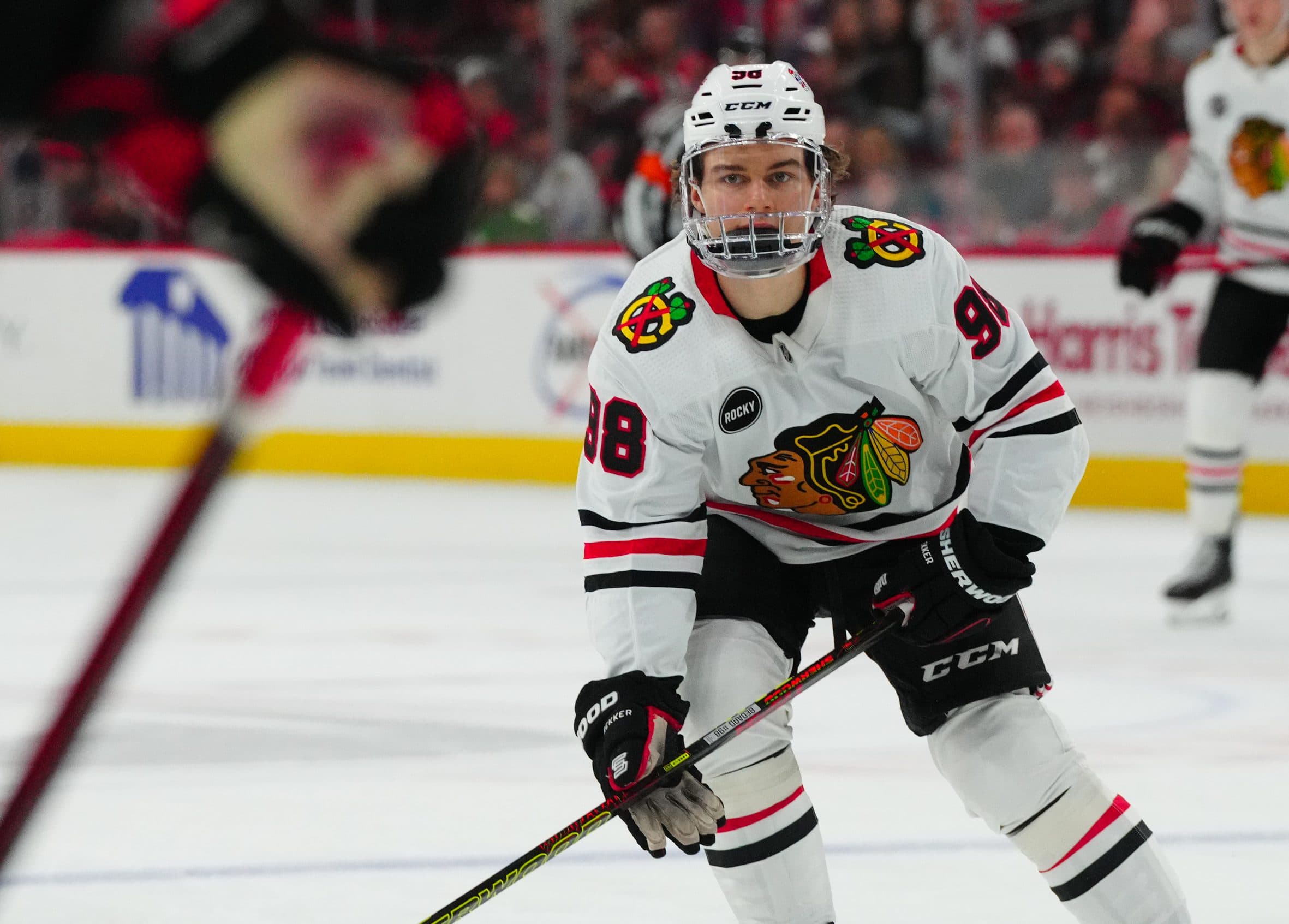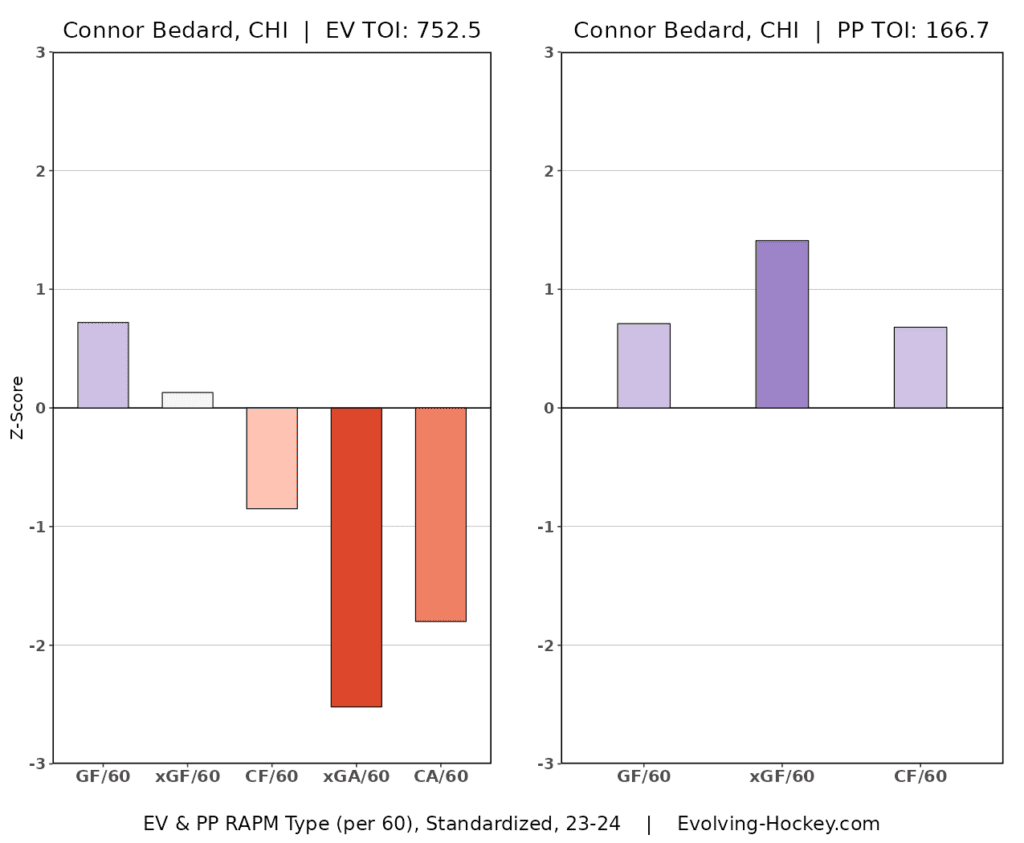How does Connor Bedard’s season compare to other rookies in the cap era?

Connor Bedard entered this season with the highest expectations since… well, the last time a young phenom named Connor made his NHL debut.
Much like McDavid, Bedard lived up to the hype with 15 goals and 33 points in his first 39 games, but that hype train was slowed to a halt with a broken jaw. Since Bedard’s return, he has 10 points in 10 games, but he hasn’t nearly gotten the attention that you would expect since only two of those points were goals and the Chicago Blackhawks have been horrendous otherwise and tough to watch.
But, that hasn’t changed the fact that Bedard’s season has been very good. In fact, it’s so good that he’s still probably the top candidate for the Calder Trophy despite missing more more than a month. But how does it compare to other rookies in the salary cap era? Has he lived up to the hype and been playing like a generational talent? Let’s take a look.
First, let’s look at Bedard’s production. Right now, he has 17 goals, 26 assists and 43 points in 49 games. Even without looking at points per game, that has him tied for 104th in the league in scoring. 15 of his goals and 30 of his points have come at even strength, and when you just focus on that game state, he moves up a bit more and is tied for 98th in the league.
But that’s among all players. If you look at just the rookies, he leads in both even-strength points and overall points, although Marco Rossi has him tied for goals and Brock Faber has him beat for assists in the latter game state.
Once you look at points-per-game, it’s a completely different conversation. Bedard leads rookies with at least 40 games played in goals-per-game by a 0.06 margin, assists by a 0.05 margin and points by a whopping 0.3. To put that last stat in perspective, that’s a difference of 24.6 points over an 82 game season. Among NHLers, there’s still a good portion of players that have him beat, as he’s only tied with Bo Horvat and Nico Hischier for 61st, but that’s still quite high for a rookie.
So how does Bedard’s production compare to rookies in the cap era? Well, his 0.88 points-per-game is tied for 12th among rookies, with four names right next to him in Jason Robertson, Cale Makar, Patrik Laine and former Blackhawk Patrick Kane. While Laine isn’t exactly the best comparable and Robertson isn’t quite generational, Bedard producing at the same level as Kane and Makar did in their rookie seasons is an excellent start, especially considering the players Bedard is playing with compared to those two.
Regarding the other generational talents, Alex Ovechkin, Sidney Crosby, Evgeni Malkin, and McDavid were all well above the rest of the pack in points per game. Whether that means that Bedard won’t be as good as them or that he hasn’t had as much success in his rookie season as those big names, we’ll still need a few more years to find out. But it’s important to note that they all produced above a point-per-game in their rookie season, with Ovechkin, Crosby and Malkin doing so in a lower-scoring era. If it’s any consolation, the only other rookie to score above a point per game in the cap era is Mathew Barzal.
The most impressive part about Bedard’s assist totals this season is how many of them are primary assists. Out of the 26 assists, 20 are primary, and his 0.41 primary assists-per-game is tied for fourth among rookies in the cap era with two other players – again, Robertson and Kane. Bedard falls just below the likes of Ovechkin and Barzal while generating them at a better per-game rate than the likes of Artemi Panarin, Malkin, Makar, McDavid, and more. That’s good company to be in.
Bedard’s goal totals haven’t been quite as impressive this season, especially since his injury, but just for the heck of it, let’s look at where his goals per game before the injury stands. With 15 goals in 39 games pre-injury, that puts him at 0.38 goals-per-game, which would be tied for 17th among rookies in the cap era with Jeff Skinner, Jonathan Toews, and Panarin. That puts Bedard 0.02 goals-per-game above McDavid, but among the other generational talents in Ovechkin, Crosby, Malkin and even Auston Matthews, they all found themselves clicking at a higher rate than him.
If you look at Bedard’s goal production under the hood, he finds himself in a similar situation. His 1.15 5v5 goals per 60 minutes is tied for 22nd among rookies, but the players that he’s tied with in Paul Cotter and Michael Bunting aren’t exactly big household names. Unfortunately, Crosby, Malkin, and Ovechkin’s rookie seasons predate the analytics era, so we don’t quite know where they stand at this point, but in terms of the modern generational talents, Bedard still finds himself just ahead of McDavid’s 1.13, but well behind Matthew’s 1.56.
But beyond goals, Bedard’s rate stats take a bit of a drop-off. His 5-on-5 primary assist rate in particular takes quite the tumble compared to his per game stats, with just 0.66 per 60 minutes that’s tied for only 113th. The list of names he’s tied with isn’t quite as sexy either, as he’s joined by Tim Kennedy, Ryan Johansen, Andrej Nestrasil, Pavel Buchnevich, Phillippe Dupuis, Matty Beniers, Austin Wagner, Anthony Duclair, Jake Evans, Dominik Kubalik, Morgan Frost and Erik Gustafsson. When only half of his primary assists are at even strength, that’s going to happen, but it’s not like Bedard is playing with the kind of talent that can produce consistently at even strength.
As far as 5-on-5 points per 60 goes, it’s a similar situation. Bedard’s 2.14 points per 60 falls all the way down to a tie for 48th with another former Blackhawk in Alex DeBrincat. It’s not even close to what we saw from McDavid in his rookie season, but it is actually quite close to Matthews’ 2.18, so it’s not too big of a concern.
That’s also the thing with points per 60. As I mentioned in my piece last week, it levels the playing field. So just because a bottom-six player is producing at the same rate as Bedard, it doesn’t mean that he’s comparable to a bottom-sixer, but more than the bottom-sixer should get more ice time. Considering that Bedard is one of the few talented players on the Blackhawks, he won’t produce as much with those less-talented teammates, especially at even strength. Add in that, according to Patrick Bacon’s WAR and player data, Bedard is in the 79% percentile of competition faced as a rookie, and it’s a bit more impressive.
And amongst all of this, I didn’t mention the other generational talent in the NHL right now: Nathan MacKinnon. MacKinnon’s rookie season wasn’t quite at the production level of other generational talents, even though he won the Calder Trophy that year. While MacKinnon is slightly ahead of Bedard in 5v5 primary assists per 60 at 0.67, he’s slightly behind Bedard in 5v5 points per 60 at 2.12, and well behind him in 5v5 goals per 60 at just 0.77. Sometimes a generational talent needs a few seasons to really produce like one, so that should alleviate any concerns about Bedard’s slightly disappointing scoring rates.
As far as Bedard’s defensive metrics go, I won’t dive too deeply into them because there isn’t really anything that pops out with them. Part of that is because he plays for a Blackhawks team that’s allowed the second-most 5v5 expected goals against per 60 this season, so it’s not exactly an environment for a rookie to learn proper defense. On top of that, the Blackhawks are the worst team in 5v5 expected goals per 60, so naturally, Bedard’s going to feel inclined to go all-in on offense to score as much as possible, much like the earlier years of McDavid and Leon Draisaitl with the Edmonton Oilers. But even then, it’s not enough on this Chicago team.

So then, let’s look at Bedard’s overall impact. His defensive deficiencies weigh down his overall goals above replacement per 60 to just 0.381, creating an interesting group of comparable rookies. On the higher end, there’s Brady Tkachuk and Sean Couturier. Still, then there are also a lot of underwhelming results, from players who only topped out as middle-to-bottom six forwards like Christian Fischer, Blake Comeau, Cal Clutterbuck, and Auston Watson to players who didn’t have overly lengthy careers in Drake Caggiula, Erik Gelinas and Peter Regin.
But Bedard’s offensive GAR per 60 improves to 0.564, which is comparable to the rookie seasons of Dylan Larkin, Anders Lee, and Brad Marchand. Now, there are still some rough lower-end comparables like Andreas Johnsson, Cory Conacher, and a more respectable Max Domi. Still, considering the offense Bedard has to work with, it’s amazing that he’s even close to Larkin and Marchand.
Finally, let’s try something that doesn’t have a ton of legitimacy, but I’m still curious to see the results. I kept a note of all the players in similar ranges of all the stats we’ve used for Bedard so far, with the range for per-game stats being as high as 0.05, while the range for per-60 stats being as high as 0.1. Amongst this massive pool of cap-era rookies, which player (or players) comes up the most?
Well, the two that did shouldn’t be a surprise because they’ve already been mentioned in this piece: Jason Robertson and Alex DeBrincat. While I’m sure Blackhawks fans will want a bit more out of a player who’s supposed to be a generational player, that at least makes for a very safe floor. And again, this means absolutely nothing; it’s just something I was curious about.
It’s safe to say that, for the most part, Bedard has lived up to the hype, and the few parts where he isn’t will likely develop to a higher level in the coming years. Even if his rate stats seem to show that his numbers benefit from getting a lot more ice time than most rookies, the MacKinnon comparison is a great example of how you can still be generational, even if you aren’t one of the best players in the league right out of the gate.
More from Scott Maxwell
- Flyers’ Rasmus Ristolainen to make season debut against Canadiens
- New Sabres GM Kekalainen on coach Lindy Ruff: ‘whole organization is under evaluation’
- Buium will make-or-break return on Hughes trade for Canucks
- How Wild’s Quinn Hughes can help unlock Brock Faber’s full potential
- NHL power rankings: Wild on another level after acquiring Quinn Hughes